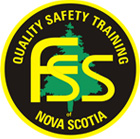Three Point Contact and Exiting Tractor
Hazards Identified
Broken ankles, broken legs, torn shoulders, sprains to ankles and shoulders
Hazard-Specific Personal Protective Equipment
CSA Grade 1 foot protection with anti slip soles, CSA approved hard hat, reflective vest
Hazard-Specific Training
Professional driver course
Safe Work Practice
Fact: Too many broken ankles and sprains occur each year in the trucking industry due to not following proper procedures.
When entering the cab, use the grab handle and access steps as follows:
- Open the driver’s door, and place in the cab any objects you are carrying.
- Grasp the grab handle with your right hand.
- Place your right foot on the bottom step and pull yourself up.
- Grasp the steering wheel with your left hand.
- Place your left foot on the top step and step up.
- Step into cab with your right foot first.
Exiting the Cab
- Do not attempt to exit cab with objects in your hands.
- Grasp the steering wheel with your left hand, and stand on the threshold facing the cab.
- Place your left foot on the top step, then grasp the grab handle with your right hand.
- Move your right foot to the bottom step.
- Step to the ground with your left foot.
Regulations, Standards and References
Occupational Safety General Regulations

